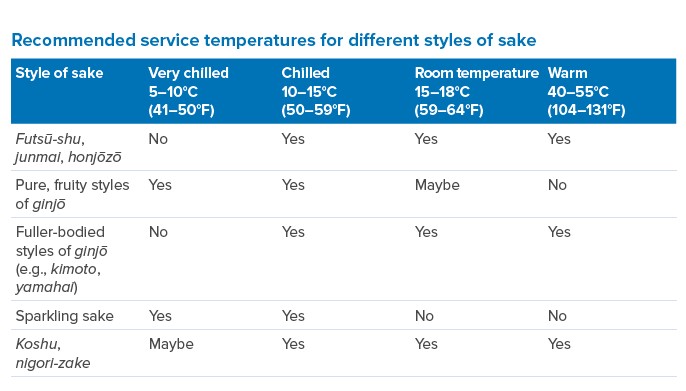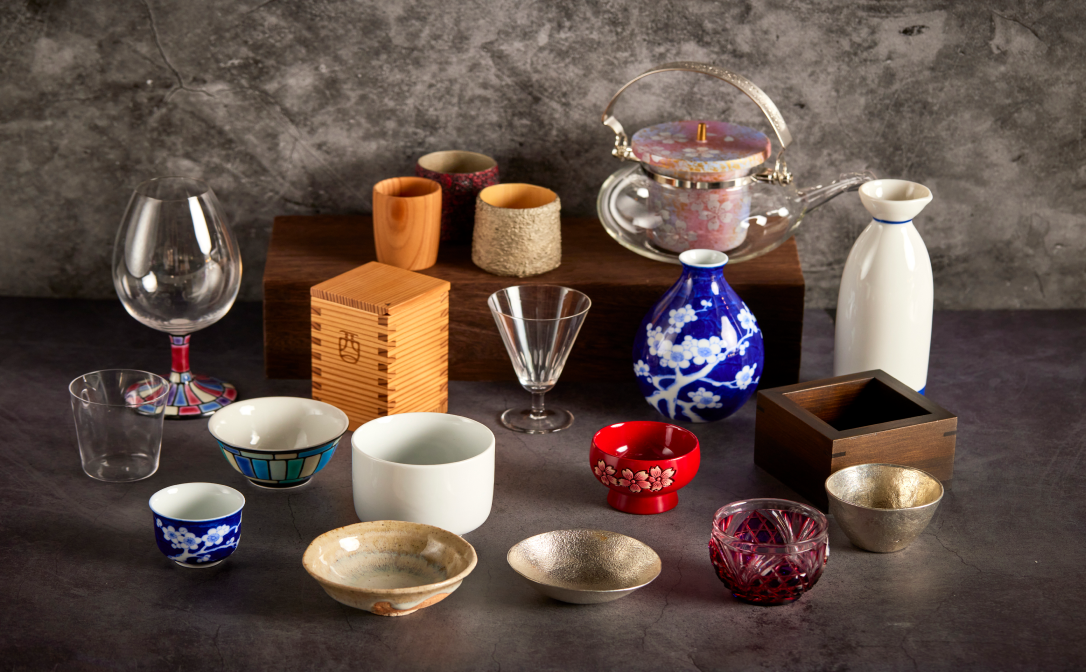Whether you’re a seasoned sake connoisseur or a curious newcomer, understanding the nuances of storing and serving can make a big difference.
In this guide, we’ll let you in on our tips for keeping sake’s unique flavours and aromas at their best. So, come along as we dive into the secrets of storing and serving sake.
Storing sake at home
Sake is easily damaged if it is exposed to heat or strong light. These tips will help to keep your sake in top shape!
Keep it cool
Even for short-term storage, sake should be kept in cool conditions (below 12°C/ 54°F) and ideally refrigerated (below 8°C, 46°F). Refrigeration is especially important for unpasteurised sakes (nama-zake) and the very fruity ginjō styles of sake. If left unrefrigerated, unpasteurised sakes can develop off-aromas and ginjō styles of sake can lose their delicate freshness.
Store the bottle upright
Sake bottles are best stored upright to avoid contact between the liquid and the closure, which is usually either a foil-lined stopper or a metal screwcap.
Avoid bright light
Sake should be kept away from strong sunshine or any bright artificial lights. The heat and the light can cause the sake to develop unpleasant aromas and a bitter taste. The sake can also become darker in colour.
Drink it young
Most sakes are intended to be consumed within a year of being shipped from the brewery. This is especially true for unpasteurised sake (nama-zake) and ginjō styles of sake. Once opened, a sake bottle should be sealed and stored in a refrigerator. Open bottles of sake generally last two weeks in the refrigerator.
Common faults in sake
Before serving sake, you should first check that the sake is free from faults. There are four main faults to look out for.
Oxidation
A bottle of sake that has been open or stored for too long, or stored at too high a temperature, loses its fresh aromas and becomes out of balance. It can eventually develop pungent aromas of pickled vegetables. The colour changes, too, becoming deeper.
Out of condition (unpasteurised sake)
Unpasteurised sake that has not been kept refrigerated or been kept for too long can develop unattractive malt, bacon and meat aromas. In some instances, other extremely unpleasant aromas can develop.
Light damage
Sake that has been exposed to strong light can develop unpleasant aromas like scorched rubber and burnt hair after just a few days of exposure to daylight or artificial light.
Microbial spoilage
While the other faults covered here develop after a sake has left the brewery, microbial spoilage is something that happens in the brewery. It can result in a wide range of unpleasant aromas, such as rotting vegetables, compost, sour milk, rancid cheese, and even sticking plaster (Band-Aid).
How to serve sake

When pouring sake, using both hands shows the most respect and care for the other person.
Sake can be served from the bottle, but it is also common to decant it into a small sake carafe, such as a tokkuri or katakuchi. If you want to serve sake in an authentic Japanese way, keep the following points in mind:
Pouring etiquette
In Japan, pouring etiquette is rather specific. Try to pour sake with both hands by holding the neck of the bottle as much as you can. The person receiving the sake should hold their cup with two hands too. Using both hands shows the most respect and care for the other person.
Pouring for others
Pouring drinks for others has a very important meaning in Japanese culture. This is the main reason sake cups are made so small. Regularly topping up each other’s glasses allows people to show that they care for each other while sharing sake together. However, you should let your customers or guests serve themselves if they insist.
Serving sake at the correct temperature
It is, without doubt, part of the unique and appealing culture of sake that it can be enjoyed at a wide range of temperatures, from very chilled to room temperature and even warm. While some sakes are equally enjoyable very chilled or chilled (5–15°C, 41–59°F), at room temperature (15–18°C, 59–64°F), or warm (40–55°C, 104–131°F), this is not the case for all sakes.
With all sake styles, there can be a risk of overchilling or overheating. Overchilling can cause the aromas in the sake to seem less pronounced. Overheating can cause the sake to lose its complexity of flavour. For example, some spicy honjōzō sakes can be heated up to 50–55°C (122–131°F), but any warmer than this could mean there is a risk that the complex sake flavours will be lost, leaving only the flavour of alcohol behind.
If you’re ever in doubt about the correct service temperature, simply refer back to this handy chart from our WSET Level 2 Award in Sake.

What should I drink sake out of?
Sake can be served in a range of vessels, depending on the sake style and temperature it should be served at.

A variety of sake vessels, including Masu and O-choko.
Wine glasses – Wine glasses are ideal for serving premium sake with ginjō aromas, either chilled or at room temperature. The most suitable glasses are small enough that the sake stays at the right temperature while it is being consumed, and tulip-shaped to enhance the aromas.
O-choko – This is the Japanese word for a traditional sake cup. These come in a range of sizes, shapes, and materials. The most common types are small pottery or glass cups that have a flat base. The small size means they must be frequently refilled, reflecting the tradition of Japanese hospitality. It is also ideal for warm sake because the small size means the sake is more likely to stay warm in the cup.
Kiki-choko – This is a specific type of o-choko. It is made of white pottery and has concentric blue circles painted on the inside on its flat base to help sake judges and brewers assess the colour and haziness of a sake. These vessels were developed for use in competitions.
Masu – This is the Japanese word for a small box made of Japanese cedar. It is not an ideal sake drinking vessel because the wood taints the sake, and the square shape is extremely difficult to drink out of. However, in Japan, sake is sometimes drunk out of a masu on ceremonial occasions. Historically they were used for measuring out rice and sake.
It is also very common to transfer sake from the bottle into a small carafe to make it easier to pour it into small o-choko cups. Two common examples of sake carafes are tokkuri and katakuchi.
Tokkuri – Tokkuri come in a range of sizes and can be made from a variety of different materials. A typical tokkuri has a narrow top and a flat base. The most common are about 150–300 mL (5–10 Us fl. Oz.) and made of pottery. Glass tokkuri sometimes have a small compartment for iced water to keep a chilled sake cool.
Katakuchi – A katakuchi is a service vessel used for chilled sake. It is a shallow open bowl with a lip at one end.
To start your sake journey, click here to find a course provider.


